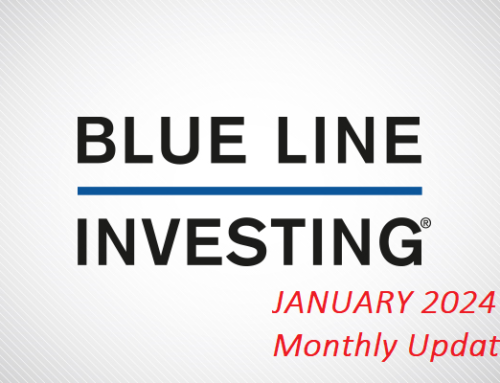“Those who cannot remember the past are condemned to repeat it.” This quote from the Spanish philosopher, essayist, poet and novelist George Santayana came into clear focus in recent months for investors in GE common stock. Excluding dividends, GE is down over 40% year-to-date. By any standard this is a significant loss and likely has had a negative impact on those investors who owned it. But did it have to be that way? Were there advance warnings for investors to hedge or sell their GE stock to attempt to limit losses? We believe the answer is yes and will illustrate why in this article.
To begin we must first take a step back in time. The BLUE LINE INVESTING™,¹ sell process was created as a result of a distribution pattern discovered during 2008. Specifically, we identified 3 specific phases of distribution that some publicly traded investments experience just prior to experiencing a significant price decline. Please refer to the chart below of the S&P 500 Index² (S&P) for calendar years 2007-2008:

Chart courtesy of StockCharts.com
For 8 months leading up to the significant part of the price decline the S&P experienced all 3 phases of price distribution, or what we refer to as WARNING, FAILURE and CONFIRMATION.* Eight months! Once the third and final phase occurred the stock price collapsed. Now, look at the chart below of GE. Do you notice what appears to be the same distribution pattern? All 3 phases of distribution occurred, and as we believe, provided ample advance warning that additional losses were likely.

Chart courtesy of StockCharts.com
Depending on what rules an investor applies to the distribution pattern above we believe they may have been able to limit their losses. If using alternative investment strategies they may have actually been able to profit from the selloff in the stock.
For those wondering if the US Stock market followed a similar “topping” process back in 2000, we invite you to review our case study on the S&P on our website.* We hope you have formulated your own sell process because as we stated in the beginning of this article, “Those who cannot remember the past are condemned to repeat it.”
Jeff Link
*For additional information please visit www.BlueLineInvesting.com/process to view our case study on the S&P.
Disclaimers:
¹ Blue Line Investing (BLI) is an alternative to traditional wealth management. BLI uses a disciplined, rules-based investment process to seek investment opportunities, regardless of whether financial markets are rising or falling. Based on technical analysis research, the process applies trend-following using specific Exponential Moving Averages (EMAs) of the market along with other technical indicators. A moving average is a widely used indicator in technical analysis that helps smooth out past price action by filtering out the “noise” from random price fluctuations. The EMA gives bigger weight to more recent prices, compared to the SMA, or Simple Moving Average which does not. EMA’s can be calculated for any time period. Some examples include the 5 day EMA; 50 day EMA; and 150 day EMA. We have attempted to simplify this by calling the various EMAs we use in our process the “Blue”, “Purple” and “Green” lines.
² The S&P 500 Index is one of the most commonly followed equity indices, and many consider it one of the best representations of the U.S. stock market, and a bellwether for the U.S. economy. It is comprised of 500 large companies having common stock listed on the NYSE or NASDAQ. The volatility (beta) of the account may be greater or less than the index. It is not possible to invest directly in this index.
Technical analysis is a method of evaluating securities by analyzing statistics generated by market activity, such as past prices and volumes. Technical analysis attempts to predict a future stock price or direction based on market trends. The assumption is that the market follows discernible patterns and if these patterns can be identified then a prediction can be made. The risk is that markets may not always follow patterns. There are certain limitations to technical analysis research, such as the calculation results being impacted by changes in security price during periods of market volatility. Technical analysis is one of many indicators that may be used to analyze market data for investing purposes and should not be considered a guaranteed prediction of market activity. The opinions expressed are those of Blue Line Investing. The opinions referenced are as of the date of publication and are subject to change without notice. Blue Line Investing reserves the right to modify its current investment strategies based on changing market dynamics or client needs.
Past performance is not indicative of future results. This material is not financial advice or an offer to sell any product. The information contained herein should not be considered a recommendation to purchase or sell any particular security. This information is intended for educational purposes only and should not be considered financial advice. It should not be assumed that the investment recommendations or decisions we make in the future will be profitable or will equal the investment performance of the securities discussed herein.
Advisory services offered through Gordon Asset Management, LLC (GAM). GAM is an SEC-registered investment adviser. Registration does not imply a certain level or skill or training. More information about the advisor, its investment strategies and objectives, is included in the firm’s Form ADV Part 2, which can be obtained, at no charge, by calling (866) 216-1920. The principle office of Gordon Asset Management, LLC is located at 1007 Slater Road, Suite 200, Durham, North Carolina, 27703.




